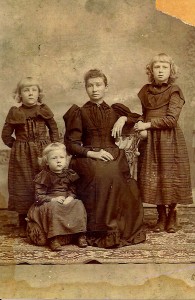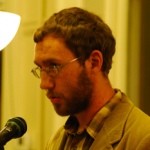Toby Altman, Series Contributor
Toby’s series “Bodies in Space” is about sustained thinking of the physicality of the body and its relation to poetry. Here, critical essay fractures, moves like poetry.
Jacob Bennett’s new chapbook from Furniture Press Books, Wysihicken [sic], takes its name from a misspelling. If you look at a map of Philadelphia, you’ll find Wissahickon, an astonishing state park which runs through the city’s Northwest neighborhoods. If such a pastoral landscape seems improbable in the heart of Philadelphia, workshop of the world, Bennett’s chapbook demonstrates how the natural is already the political: implicated in violent acts of naming and appropriation, which turn Wysihicken into Wissahickon.
Bennett conducts an archaeology of the park: examining, in tightly constructed poems, its human and natural history. He documents how the poem’s Arcadian setting serves “as microcosom or repository of the foundations of the United States of America. Appropriation and dominion, naming as claiming, domination and change – these are American themes and the themes of this poem.” The park becomes a “petrified directory” for reading, reproducing, and critiquing the cycles of colonial violence which have made and shaped the ‘natural.’ I interviewed Jacob about his chapbook, its politics and its aesthetics, over the month of June, while he prepared for his wedding.
Toby Altman: I’d like to begin by talking about the tradition of romantic landscape writing. Wordsworth, for instance, famously composed while walking, and the rhythm of the footfall insistently frames his poems. We might say that romantic landscape poems rely on the poet’s body—a centripetal presence which organizes the natural. Your poem too begins with the poet’s rhythmic movement through the landscape: “I began composing the first sections of this poem in my head while riding my bike through Wissahickon Creek park in Philadelphia’s northwest quadrant,” you write. But your poem itself effaces this presence; the word ‘I’ is ostentatiously absent from the poem. Talk about your relation to the tradition of landscape poetry: if your poem breaks from that tradition, what is at stake politically and aesthetically in the breaks?
Jacob Bennett: While I had Bishop (“Florida”) and Olson (“Maximus to Gloucester, Letter 27 [Withheld]”) in mind, and not Wordsworth, the connection to that tradition is there. It’s gratifying that you notice the friction between what I was very consciously thinking of as a lyrical tradition of R/romantic landscape writing, on one hand, and the total absence of an ‘I’ in my own poem. It’s an artifice, to be sure, the erasure of my Self as a central filter for sensory input. Because, of course, it IS me walking, splashing, riding, reading, touching, smelling. There were, in early drafts, some ‘I’ references, but at some point I (ahem) decided that, in order to compose something that was bigger than me or my subjective experience of a very beautiful landscape, and my third-hand reader’s experience of a very brutal history, that there should be no center or axis, at least not in the form of a “me as center of everything,” around which the poem might revolve. As far as the lines, which are sometimes short, sometimes long – I’m thinking of your comment about Wordsworth’s peripatetic rhythm – I guess the poem is a specimen of concrete poem, as I was trying to match the lines of the rocks, and the water, and the trails, along which I traveled.
TA: I’m interested in what you say about the shapes of the poem. It seems like the poem is not merely descriptive of a landscape, but also mimetic of it. I wonder if this is true of the poem’s language as well as its shape. The language of the poem is at once austere and heteroglot, impacting geological, industrial and lyric vocabularies. In the Author’s Note, you write, “I realized…there is no way to pin down a place by naming it or telling its story. After all, even bedrock fractures and loses its place.” Talk about the relation that this poem establishes between language and place. Is the groundlessness of place also the groundlessness of language? How do you accommodate one to the other? (I particularly want to hear about the neologisms, like ‘millspins’ and ‘glasswater,’ which are so much a part of the distinctive fabric of this poem).
JB: Yes, I think that’s right, that place and language are, if not groundless, then definitely ungrounded or unstable over time, even if the shifts are unnoticed or so slow as to take ages. The first time I read the ‘misspelled’ name of the Wissahickon that is the poem’s title, it was attended by an editor’s notation indicating the ‘found’ nature of the spelling: [sic]. The sound of the combination—Wysihicken [sic]—echoed in my head for a while before I realized that was the title. And then I realized that the alternate spelling was a perfect carrier of the idea of slippage, as in the sliding of continents over and under each other, and also of the arbitrary nature of spelling and labeling. Sure, today there are geometric shapes on a map that represent the creek, the creek’s protected parkland, the creek’s watershed, but those shapes, and the names applied, have changed and will change. What’s in a name? Well, Wissahickon is a suburban refuge for urban citizens. Wysihicken [sic] is a conglomerate of Dutch colonists, and Lenape tribes, and German Rosicrucian doomsdayers, with tongues that make sounds unfamiliar to, alien to, the English of my own tongue. And I wanted to capture that, the way a spelling can change something so familiar, both in the eye and maybe even in the ear. And, since you mention the neologisms and other diction choices, I should say that I strove for the occasional ‘clumped-up’ compound word, which I saw as mimetic, too, of the clumping of various materials in the forest. I wanted, too, with ‘glasswater,’ to express the very specific look of the still, flat, mirrored surface of the creek on a windless day, but the way it juxtaposed with ‘Ganshewehanna’ (‘noisy water’), the Lenape name for the Dutch-named Schuylkill, was also very attractive to me. So I used a trick I learned from my study of German, and from Truman Capote (‘summeryellow’ he wrote, somewhere, I swear), compounding a new word. Amelia Bentley suggested I get rid of ‘simmering,’ and I agreed. But before striking the word, I looked up the etymology, and discovered that in addition to our received idea of ‘slowly boiling,’ the word has older meanings related to ‘cement.’ That the word holds both these meanings, simultaneously, of movement and stasis, meant that it had to stay. As for the shapes of the poem, there is definitely a mimetic quality to the look of the poem on the page, and that was important to me from early on—I was interested in there being another layer or facet to the language, something that might come through in the layout. Cristophe – as you know, publisher for Furniture Press – made a really great suggestion that I try for something more organic, less ergonomic and clean, than the blocky original layout. So I changed the measurement of the ‘tab’ key, seven hundredths of an inch, rather than half an inch, in order to achieve something more sinuous, less rigid.
TA: We’ve been talking about the ‘groundlessness’ of language and place in your poem. You refuse to treat this as a metaphysical condition; instead, you document the colonial and industrial violence that turns Wysihicken into Wissahickon. I’d like you to talk about the poem’s political strategies: does its mimetic commitment preclude taking a political stance on the violence it documents? Or is mimesis itself urgently political?
JB: I want to go in all the directions in order to answer that! I’ll start by saying that, while I do try to anchor my ‘groundless’ language in the literal as much as possible—historical accounts, geological data—I am very much interested in the metaphysical questions ‘what might be?’ and ‘what might be the nature of that Might Be-ing?’ I am just as likely to think of myself as a staunch materialist as a believer in things unseen. To go ‘way out there,’ and to fuse those parts of my mind, it may be useful to quote NASA: “everything on Earth, everything ever observed with all of our instruments…adds up to less than 5%” of the universe. Ontologically, we’ve got a lot of work to do to “order” the universe, what is likely an impossible goal. It is, though, comforting to the materialist in me to revel in the work of Linnaeus; naming things and categorizing them lends a sense of order, and control, to what is the riot of existence, and I do find great pleasure in naming that red bird with the peaked head feathers, black face feathers, and blood-orange beak: “cardinal.” But, of course, this aspect of mimesis, names as representations, is abjectly political. Look at the ongoing ‘Redskins’ situation. And mimesis as mimicry, too, is political. Look at recent uproar surrounding texts by Jeff Nagy or Josef Kaplan, among others who create or channel personae to some artistic end. I suppose mimesis is inherently political, if not urgently so, so even if I try to limit or preclude a political stance, I will inevitably fail. Even abstention is a stance, after all. But I think I’ve taken a stance in Wysihicken [sic], at least against violence. Not very courageous, admittedly. I am no panglossian, hopeful for an end of the kind of ethnic violence that occurs in the poem, or and end to a hierarchical view of culture or the attendant colonialism that allows for the violence in the first instance, but I believe in the ‘truth’ of the idea that “butchers and their wives / fatten upon the smell of fog” (where fog is ignorance, distraction, and obfuscation), and I am eager to keep in mind the idea that Earthly paradise is just as appropriate a setting for human atrocity as any other locale. I’m thinking now of Williams’ notion that one might access universal ‘truth’ via “contact” with the locality of one’s actual experience, so while I don’t fool myself or anyone else into thinking that a poem, or a news report, or a trending hashtag, will necessarily repair or prevent atrocity, the acknowledgement of such is important to me. That’s why I love Juliana Spahr’s This Connection of Everyone with Lungs. It is an acknowledgment, down to the molecular level, of such violence. Even if only to say, metaphysically, “this is why we can’t have nice things.” I suppose my overall stance is that affiliation, communion around commonality (wherein tradition or ritual is a kind of mimesis), is good for building a sense of attachment or community, but taken to extremes it becomes divisive and inevitably violent. That’s where a love of cataloging, of that vestigial hierarchy of Linnaeus’, can run into an ethical morass.
TA: I’d like you to talk about how this chapbook fits into your broader projects. It seems, in its mimetic detail and its formal austerity, quite different from some of your other work—I’m thinking for instance of the poems you read at the Penn Book Center in March 2013, which were prose-y, carnivalesque, detailed, lush, and very political. Do those poems share the same politics of mimesis? Or is your politics strategic, responsive to the form and subject of your poems? Better, what’s next?
JB: Oh, yeah, the prose poems (from a manuscript titled seeking blank slate: postcards out of eudaimonia) are a different thing altogether! One of the major differences between eudaimonia and Wysihicken, which I wrote in that order, is that, while political, the ‘postcard poems’ are also very, very personal. I began that series of poems after a particularly difficult breakup, which left me alone in a new city without friends or a network of support, ruing and jealous and self-flagellating. I think, for the first time, I really started to address my own undesirable qualities (the rue and jealousy and self-flagellation, among others) and to write about them, learn from them, maybe rewire my emotional register and behavior a little. And that led to a larger investigation of privilege, my own, as white, male, cis, straight, blonde over blue…I mean, go down the list of American ‘leaders,’ especially early on, and you’ll see some of the biggest bullies and tantrum-throwers, and I was trying to prove to myself that I wasn’t that guy. You know, that I wasn’t Jefferson or Washington, spouting one politically benevolent ideology and doing quite the opposite in the day-to-day. That’s an extreme example, but, I think it makes a point. So, it’s a text that addresses issues both personal and political, and leans, I guess, not toward resignation but maybe reconciliation, with some outbursts along the way. Getting right with the political identity I’ve got, and making sure what I believe and do are in alignment, and trying to adjust as necessary. I was very interested in getting myself into those poems, and—to address the question of broader projects or approach—since I have anxiety about repeating myself, I usually strive for formal and stylistic and tonal shifts between one manuscript and another. Hence the austerity, the mimetic concrete-ness, the “I”-less-ness of Wysihicken. I bet someone could do it, but I can’t even think about writing that poem as first-person lyric! As for next, I’m working more on establishing a practice and facility with translation, specifically of Petr Bezruč, a Czech poet who wrote his major work in just a handful of years at the cusp of the 19th and 20th centuries. There are other original works I’ve got going, but they’re still somewhat nebulous or ill-formed, as ideas and also in many instances as poems. But they are, for the most part, short-ish, kind of like Wysihicken segments, but a lot snarkier. As a way of closing, I’d like to thank you—so much!—for such great, probing questions. Thanks, Toby!!
≅
 Toby Altman is a conceptual poet. His poems have appeared. He is the author of and the recipient of. He currently lives in, where he works as and serves on the editorial board for. For more of his, please visit his and follow him on.
Toby Altman is a conceptual poet. His poems have appeared. He is the author of and the recipient of. He currently lives in, where he works as and serves on the editorial board for. For more of his, please visit his and follow him on.








